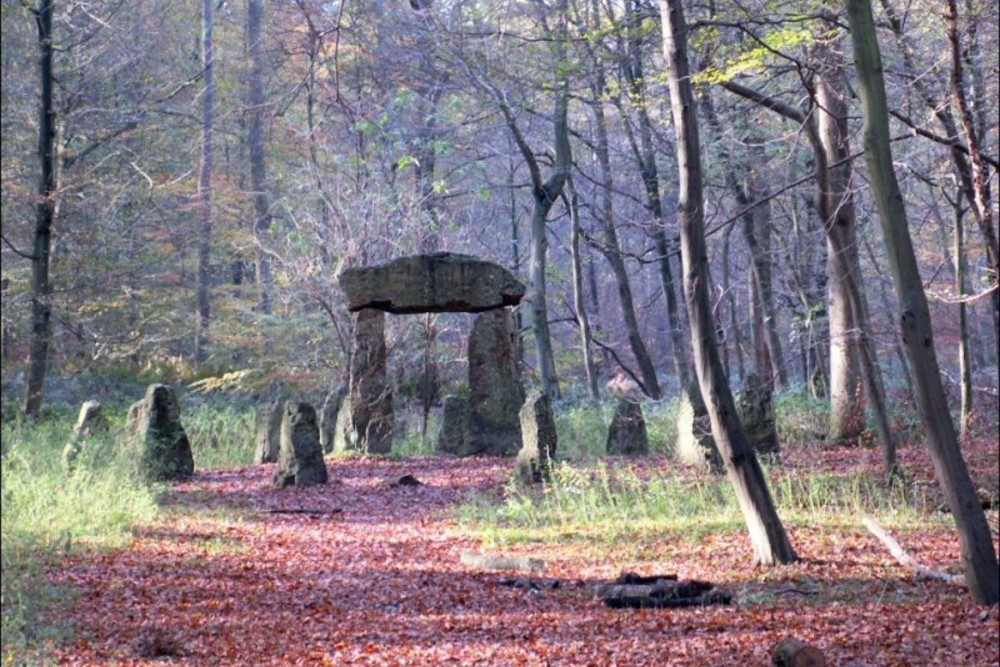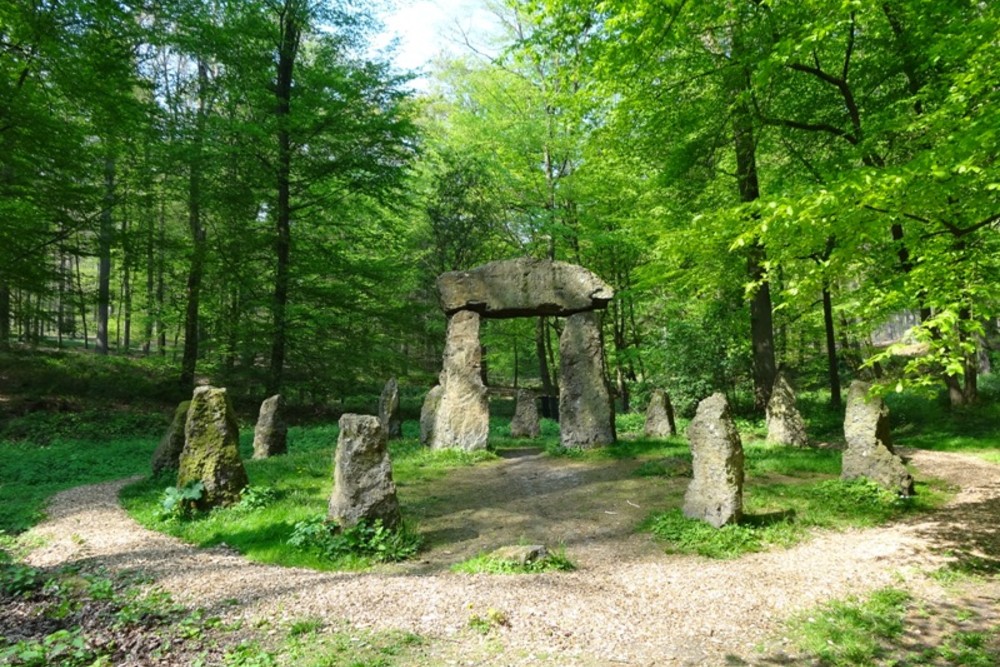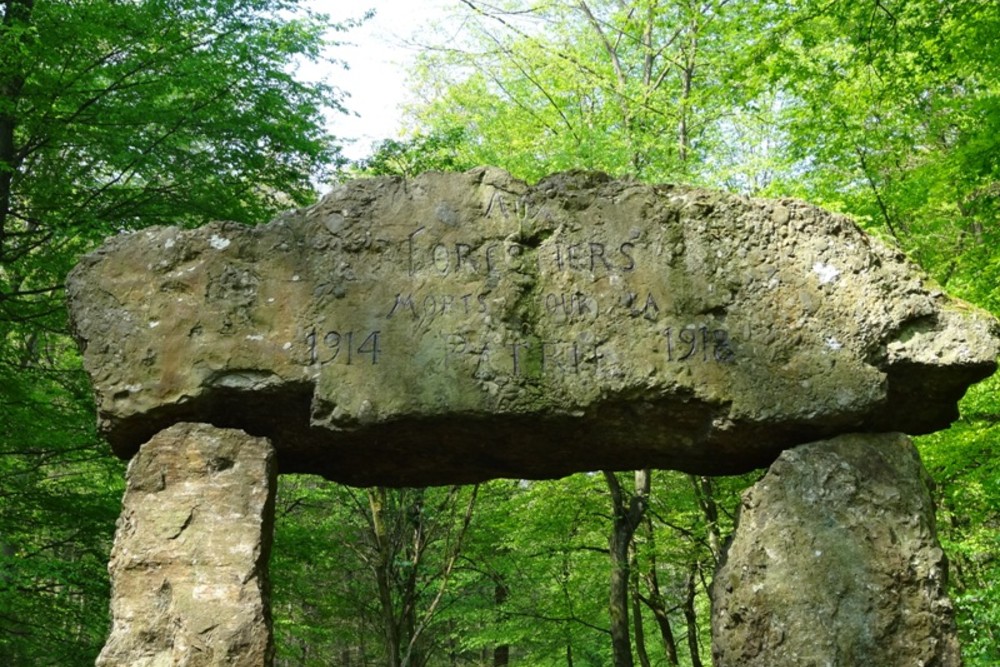War Memorial Zoniënwoud
This memorial in the Zoniënwoud / Forêt de Soignes commemorates 11 Belgian foresters who were killed or missing in the First World War.
Location:
In the Sonian Forest, on the territory of the municipality of Uccle in the Brussels Region, along the Grasdellepad (close to the intersection of Harasdreef and Bundersdreef).
Information:
The monument was created on the initiative of Mr. Crahay, who was director general of the Waters & Forests department at the time. He wanted to use it to commemorate the forest rangers who had fallen during WW1 or were shot by the German occupiers. To finance it, he organized a fundraising campaign, to which numerous large wood processing companies subscribed. Various prominent figures, cities, municipalities and clubs also contributed.
With the collected budget, the substantial amount of exactly 23,353.50 Belgian francs for that time, it was possible to get to work and an artist was appointed to design the monument. The choice fell on Richard Viandier.
Viandier was born in 1859 in Nil-Saint-Vincent in Walloon Brabant. From 1897 to 1914 he regularly worked with the agency Waters & Bossen for which he organized various exhibitions. He was part of the School of Tervuren, a group of artists who chose Tervuren and painted the same subjects, such as the Sonian Forest, in the same style. Viandier was known as a loner. He was also called "l'homme du bois" or quickly translated "the forest man" by his colleagues, because he spent a lot of time in the forest. Viandier was therefore very interested in the Sonian Forest, especially the towering beeches. They therefore frequently appear in his paintings, where he let the light play between those trees and the shrubs or water features below. A number of those paintings can still be viewed in the town hall of Hoeilaart.
When his monument to the foresters was unveiled in 1920, Viandier became a Knight of the Order of Leopold - in 1931 he himself was promoted to Officer of the same order. In 1949 he died.
For the monument, "forest man" Viandier was inspired by the funeral rites of the Celts, to which he added the romantic touch that was so popular at the time. The whole site has the shape of a "cromlech" - a circle of stones and was made of pudding stone from Wéris in Wallonia, not coincidentally the center of megaliths in Belgium. Eleven monoliths are arranged around a central portico bearing the words "Aux forestiers morts pour la patrie 1914-1918". As was customary at the time, no translation into Dutch was made. It was not applied afterwards either. In Dutch, the inscription means as much as "Dedicated to the foresters who died for the fatherland 1914 - 1918".
The eleven small menhirs thus pay tribute to these 11 fallen or executed forest rangers:
Jean-Pierre-François Bieuvelet, forester in Thibessart - shot on August 22, 1914, together with his son
Gustave-René Coulon, forester in Etalle - hanged from a tree and then shot on August 22, 1914
François-Joseph-Jules Cozier, chief forester - executed on 26 August 1914 in the Arlon massacre in which 108 men and 1 woman were killed in revenge for allegedly shooting at the German troops by civilians.
Servaas Dauchy, forester in Westouteren - shot in October 1914 at the gate of the cemetery because he carried his service revolver.
Pierre-Jacques-Félix Graisse, forest ranger in Latour - shot on 24 August 1914 in the Latour massacre in which 70 men from the village of Latour died. They were forced to first bury the fallen soldiers on a nearby battlefield and then to dig their own graves, after which they were killed.
Arthur-Joseph Liégeois, forester in Daverdisse - killed in action on 22 February 1918
Philippe-Augustin-Joseph Marinier, forester in Chimay/Forges. He was a Corporal in the 1st Foot Fighters when he was wounded on 22 October 1914 and was awarded the War Cruiser Decoration. He lived through the entire war behind the Yser, but was killed on October 3, 1918. According to eyewitnesses, he was hit by a bullet from a German plane. In a preserved letter from his father, however, he indicates a different cause of death: his son is said to have been torn to pieces by the impact of an shell near the Koffiemolenhoek in Oostnieuwkerke. The eyewitnesses probably wanted to introduce it better to his parents and therefore lied about the plane.
Alphonse Orban, forester at Villez-Laroche, served in the 14th Line regiment - killed in action November 1914.
Charles-Valère Peygnard, forester in Etalle - killed in action in December 1917. He was fatally hit by a German shell, when he was relieved after 3 days in the trenches and could go to the hinterland to rest.
Alphonse-Emile Robert, forester at Anlyoy - shot on August 23, 1914
Albert-Antoine-Ghislain Simon, forester at Soulme - died as a private cyclist of the 1st line regiment in August 1914, when his unit was withdrawing from Namur.
On May 30, 1920, the monument was unveiled and a liberty tree was also planted. The unveiling was attended by Count Amédée Visart de Bocarmé, as a politician and forestry worker the perfect chairman of the organizing group, by Baron Albéric Ruzette, then Minister of Agriculture (which included Waters & Bossen) and by Count Henri Carton de Wiart, who later year would become Prime Minister of Belgium.
Nowadays, because of its shape, the monument is also used by the Druids of Belgium for rituals and celebrations.
Do you have more information about this location? Inform us!
Source
- Text: Tim t' Kint & Fedor de Vries
- Photos: Tim t' Kint
Nearby
Museum
- Wellington Museum - Waterloo
- Royal Army and Military History Museum - Brussel
- National Museum of the Resistance - Anderlecht
Point of interest
- Garden Victor de Laveleye, Creator of the V(ictory) Sign - Sint-Gillis (Brussel)
- Law Courts of Brussels - Brussel
- Watch Building Bloc Dubreucq - Brussel
Monument
- War Memorial Cemetery Watermaal-Bosvoorde - Watermaal-Bosvoorde (Brussel)
- War Memorial Watermaal-Bosvoorde - Watermaal-Bosvoorde (Brussel)
- Memorial Veterans Watermaal-Bosvoorde - Watermaal-Bosvoorde
Cemetery
- Belgian Graves Veterans Watermaal-Bosvoorde - Watermaal-Bosvoorde (Brussel)
- Belgian War Graves Watermaal-Bosvoorde - Watermaal-Bosvoorde (Brussel)
- Belgian Graves Veterans Linkebeek - Linkebeek
Remembrance Stone
- Stumbling Stone Avenue de Visé 80 - Watermaal-Bosvoorde (Brussel)
- Stumbling Stone Avenue Jean van Horenbeeck 40 - Oudergem (Brussel)
- Stumbling Stone Avenue Brillat-Savarin 92 - Elsene (Brussel)






